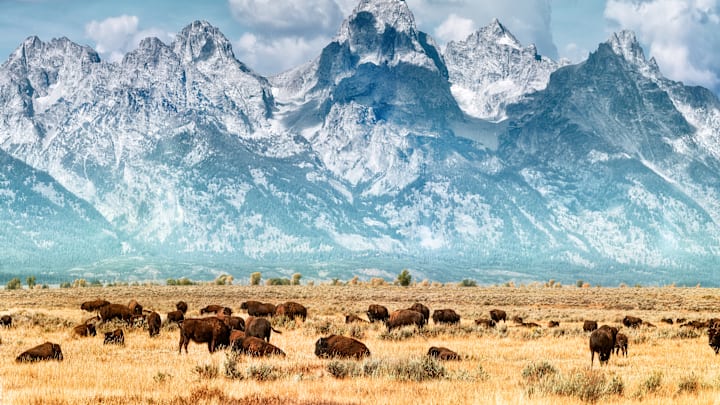Yellowstone is currently home to the oldest and largest natural bison herd in America, but the mammal‘s population in the park wasn‘t always this healthy. Their numbers were under two dozen around the early 1900s—much less than the 5000 bison there today. Thanks to conservation efforts, the species has rebounded, and now scientists are closer to understanding just how essential these mammals are to the park’s well-being.
Bison Are Helping Yellowstone’s Ecosystem

A new study published in the journal Science shows that migrating bison significantly contribute to Yellowstone’s nitrogen distribution cycle. Nitrogen is necessary for healthy plant growth. The chemical element is a vital component found in various parts of a plant, from the chlorophyll in its leaves to proteins and enzymes in its roots. Because bison leave behind dung—a.k.a. fertilizer—wherever they graze, the plants that grow there turn out to be healthier, too.
Study co-author Bill Hamilton, an ecologist at Washington and Lee University, and his colleagues determined this after comparing grazed and untouched land. They also studied satellite imagery and GPS collar data over time to observe bison migration habits and the herd‘s impact on the land. The primary objective was to investigate the differences in plant growth and diversity, nutrient cycling, and microbial abundance in the soil between the two types of areas. The experts looked at 16 sites between 2015 and 2022.
You May Also Like:
- How the Return of Wolves to Yellowstone Helped Aspen Trees Thrive
- 6 Fascinating Marsupial Facts You Probably Didn’t Know
- Just Touching the World’s Most Dangerous Tree Could Send You to the Hospital
Although some experts believe that free-roaming bison may lead to overgrazing and disease, this new study suggests otherwise. The researchers found that bison are a significant contributor to the rise in microbes found in grazed soil. These microbes, which come from bison poop, are responsible for increased nitrogen in plants, which dramatically boosts their nutritious value by up to 150 percent. Additionally, the fertilized soil can better retain nutrients, and plant diversity also improves.
These effects may be hard to replicate outside Yellowstone, however. Bison can only benefit ecosystems in this way when they have ample space to move. The Yellowstone herd travels 1000 miles each year, which is how they’ve helped grasslands there to thrive.
